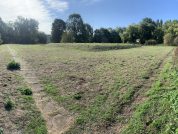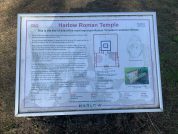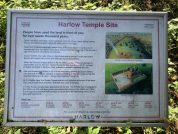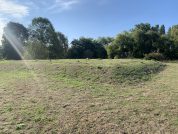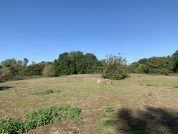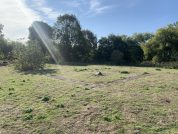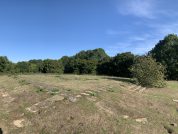Harlow Temple
Temple Or Shrine
The Foundations of a ‘Romano-British’ temple were found during excavation at Harlow in the 1950’s. This square temple lies in a temenos or ‘sacred enclosure’ on a low hill beside the River Stort. The outer portico measures 54½ feet square, the inner cella 24¾ feet square, both interior and exterior walls being a uniform 3 feet in thickness. Wall-plaster was found in the front wings of the building. Built in the late-3rd and in use until the late-4th centuries, the temple faces south-east. The temple is of particular note as it is one of only fifteen or so known Romano-British temple buildings in Britain, and the only one fronted by a substantial rectangular porch, which is the same width as the outer colonnade and extends some 13 feet to the south-east, being of a lighter construction than that of the templum proper. (Type Ib or Ic, or IIb/c)
Excavations in 1970
TL470127 – During machine trenching by building contractors on the east bank of the River Stort at Holbrooks in 1970, four Roman buildings were observed, one of which sported a hypocaust heating system and a mozaic floor. Portable finds included small votive axes and spears of bronze, a miniature pewter jug and parts of three guilt-bronze letters: part of a letter A; part of a vertical upright, perhaps of an M or N; and the vertical upright of a letter L.
Classical References to Harlow
Harlow Essex. Herlawe 1045, Herlaua 1086 (db). ‘Mound or hill associated with an army (perhaps a Viking army).’ OE here + hlaw.” (Mills)
It is not beyond the realms of possibility that Harlow was mentioned in the The Ravenna Cosmography of the seventh century A.D., appearing perhaps as one of the four settlements listed between Durobrabis (Rochester, Kent; R&C#74) and Utriconion Cornoviorum (Wroxeter, Shropshire; R&C#79). These stations are:
- #75 Landini – possibly a duplicate entry for Londinium (London).
- #76 Tamese – possibly associated with or located upon the Thamesis (River Thames) or a tributary stream.
- #77 Brinauis – location totally unknown.
- #78 Alauna – a common place-name, there being several known in Britain.
Roman Harlow may be any one of these stations, or it may not be represented at all. The Tamese entry in particular looks hopeful because Harlow lies upon the River Stort, a tributary stream of the Thames. Another tentative contender is the name Alauna, which may be associated in some way with rivers or with water in general, for example Maryport in Cumbria (Alauna Carvetiorum) lies at the mouth of the River Ellen, and Learchild in Northumberland (Alauna Votadinum) is associated with the River Aln, which was itself named the Alaunus in Roman times (q.v. R&C#283). With reference to the derivation of the modern place-name quoted from Mills above, the transition Alauna – Herlaua – Harlow, may be more than just a coincidence.
Other Nearby Roman Remains
The remains of another substantial Romano-British building were uncovered close by the Harlow temple (at NGRef. TL4712), but no details are currently available. There was also a villa at Hallingbury in Essex (TL4916) along the Stort about 3½ miles upstream, and a pottery at Bromley Hall in Hertfordshire (TL4121) about 5½ miles along the road to Braughing at the crossing of the River Ash.
Visiting Harlow Temple
Harlow Temple is let down by its location. You have to navigate an industrial estate, find the badly signposted entrance and then find a parking place that wont clamp you. After you walk through the overgrown path, avoid the beer bottles you get the the quite nice site of the Temple. One saving grace is the nearby museum, which you would have to drive through, helpful staff and a lot of panels about the area in Roman times.
References for Old Harlow
- Oxford Dictionary of English Place-Names by A.D. Mills (Oxford 1998); Britannia ii (1971) pp.272/3, 289 & 295;
- Temples in Roman Britain by M.J.T. Lewis (Cambridge 1966);
- The Roman Inscriptions of Britain by R.G. Collingwood and R.P. Wright (Oxford 1965);
- A Romano-British Temple near Harlow, Essex in Ant. J., viii, pp.300-326;
Roman Roads near Old Harlow
NW (10) to Bravghing River Stort Upstream: NE (6) to Bishops Stortford (Essex) River Stort Downstream: S (23) to Londinivm
Sites near Harlow Temple
- Bishops Stortford (9 km)
Minor Settlement - Braughing Roman Trading Post (14 km)
Iron-work and Minor Settlement - Great Dunmow (19 km)
Minor Settlement - Little London, Chigwell (Durolitum) Roman Settlement (22 km)
Minor Settlement - Lockleys Roman villa (23 km)
Villa - Dicket Mead Roman villa (23 km)
Villa - Welwyn Roman Baths (24 km)
Bath House and Villa - Welwyn Settlement (24 km)
Major Settlement - Chelmsford (Caesaromagus) Roman Settlement (25 km)
Mansio, Minor Settlement, Roman Temple Or Shrine and Romano-british Temple Or Shrine - Caesaromagus Mansio (25 km)
Mansio
